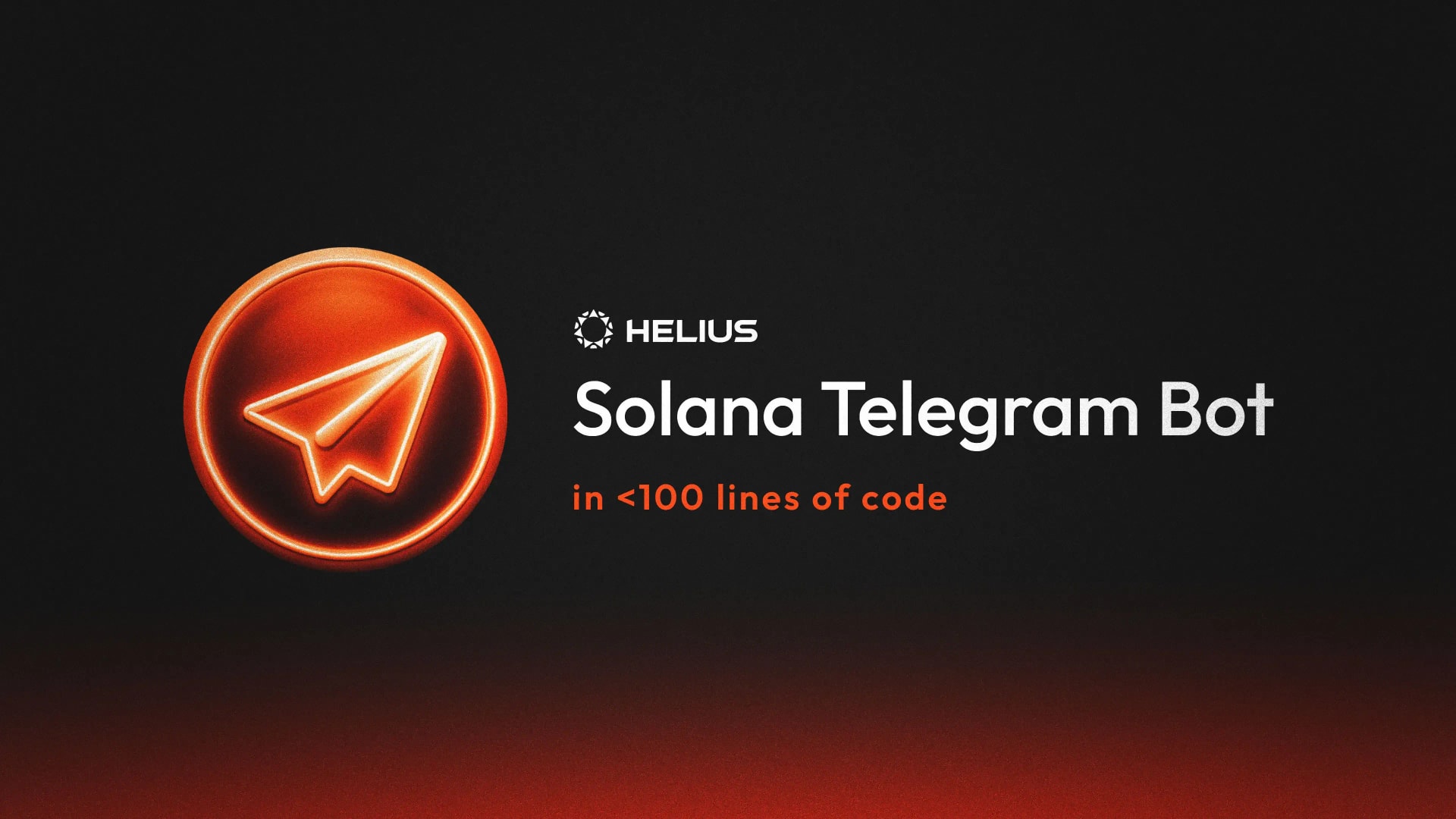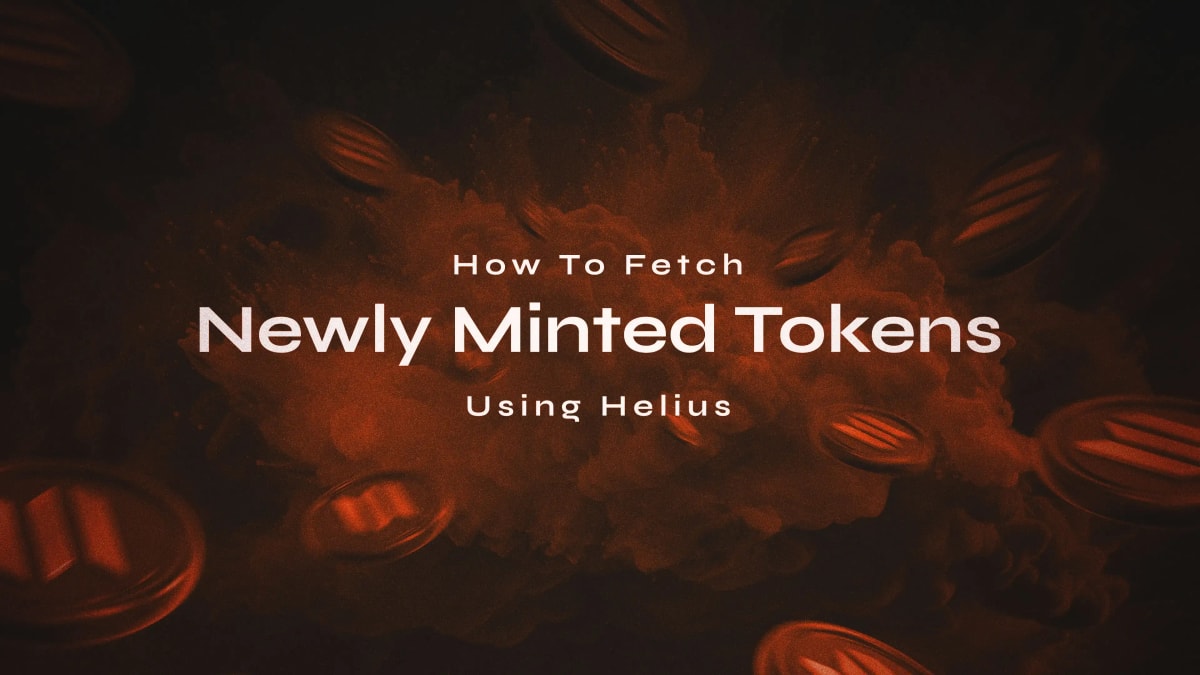
Create a Solana Telegram Bot in Less Than 100 Lines of Code
Want to stay updated on Solana events in real-time? This guide will show you how to create a Telegram bot that can track on-chain activities. We'll use an NFT sales tracker as an example, but the template we're building can be easily adapted for other use cases.
Here's what our example bot will look like:
This template combines Helius webhooks for real-time Solana data with Cloudflare Workers for serverless hosting. Whether you're tracking NFT sales, monitoring DeFi protocols, or keeping an eye on specific wallets, this setup provides a solid foundation.
Setting Up Your Project
Let's get your project up and running:
1. Clone the repository
git clone https://github.com/helius-labs/cloudfare-telegram-template.git
cd cloudfare-telegram-template2. Install dependencies
npm install3. Configure environment variables
Open wrangler.toml and fill in the following keys:
TELEGRAM_BOT_TOKEN
- Open Telegram and search for @BotFather.
- Start a chat with BotFather and send the command
/newbot. - Follow the prompts to choose a name and username for your bot.
- Once created, BotFather will give you a token. This is your
TELEGRAM_BOT_TOKEN.
TELEGRAM_CHAT_ID
- Create a channel and add your bot as an administrator.
- Send a message to the channel.
- Visit: https://api.telegram.org/bot<YOUR_BOT_TOKEN>/getUpdates
- Find the
"chat":{"id":field in the response. This is yourTELEGRAM_CHAT_ID. - Watch this video for a step-by-step guide:
HELIUS_API_KEY
Your Helius API key (get it from Helius)
AUTH_TOKEN
Open bash and generate a unique AUTH_TOKEN:
openssl rand -base64 32Note:
Do not commit these values to Github.
4. Deploy to Cloudflare
npm run deployAfter running this command, you'll see your deployment URL in the console output. Make note of this URL as you'll need it in the next step.
5. Create your webhook
Use the deployment URL from the previous step to create your webhook:
curl -X POST https://your-worker-url.workers.dev/create-webhookNote:
Replace "your-worker-url" with your actual worker URL.
You'll receive a success response after running this command.
You can view the new webhook you've set up on your Helius dashboard.
Note
It may take 2-3 minutes for the new webhook to fully spin up and become operational.
6. Edit your webhook
After creating your webhook, you can customize it further in the Helius dashboard:
- Go to the webhooks section in your dashboard
- You should see your newly created webhook in the list.
- Click on the webhook to edit its settings.
- Here you can modify various parameters such as:
- Transaction types you want to track
- Specific wallet addresses to monitor
- Network (mainnet, devnet)
Important:
Keep the "Webhook URL" field unchanged. It should still point to your Cloudflare Worker's /webhook endpoint (https://your-worker- url.workers.dev/webhook).
The Code Breakdown
First, let's examine our imports and type definitions:
import { Hono } from 'hono';
type Env = {
HELIUS_API_KEY: string;
TELEGRAM_BOT_TOKEN: string;
TELEGRAM_CHAT_ID: string;
AUTH_TOKEN: string;
};
We're using Hono, a lightweight web framework for Cloudflare Workers. The Env type defines our environment variables for Helius and Telegram integrations.
Next, we set up our Hono app:
const app = new Hono<{ Bindings: Env }>();
app.get('/', (c) => c.text('Solana Action Bot is running!'));This creates our app and sets up a simple health check endpoint.
Now, let's create our webhook:
app.post('/create-webhook', async (c) => {
const webhookURL = `${new URL(c.req.url).origin}/webhook`;
console.log('Setting up webhook with URL:', webhookURL);
const response = await fetch(
`https://api.helius.xyz/v0/webhooks?api-key=${c.env.HELIUS_API_KEY}`,
{
method: 'POST',
headers: {
'Content-Type': 'application/json',
},
body: JSON.stringify({
webhookURL: webhookURL,
transactionTypes: ["NFT_SALE"],
accountAddresses: ["M2mx93ekt1fmXSVkTrUL9xVFHkmME8HTUi5Cyc5aF7K"], // Magic Eden v2 program
webhookType: "enhanced",
authHeader: c.env.AUTH_TOKEN
}),
}
);
const data = await response.json();
console.log('Helius webhook setup response:', data);
return c.json({ success: true, webhook: data, webhookURL: webhookURL });
});
This endpoint sets up our Helius webhook. In this example, we're tracking NFT sales from the Magic Eden v2 program, but you can modify the transactionTypes and accountAddresses to suit your needs.
Here's how we send messages to Telegram:
async function sendTelegramMessage(message: string, env: Env) {
const url = `https://api.telegram.org/bot${env.TELEGRAM_BOT_TOKEN}/sendMessage`;
const response = await fetch(url, {
method: 'POST',
headers: {
'Content-Type': 'application/json',
},
body: JSON.stringify({
chat_id: env.TELEGRAM_CHAT_ID,
text: message,
parse_mode: 'Markdown',
}),
});
return response.json();
}This function formats our message and sends it to our Telegram chat.
Finally, let's handle the incoming webhook data:
app.post('/webhook', async (c) => {
const authToken = c.req.header('Authorization');
if (authToken !== c.env.AUTH_TOKEN) {
return c.text('Unauthorized', 401);
}
let data;
try {
data = await c.req.json();
console.log('Received webhook data:', JSON.stringify(data, null, 2));
} catch (error) {
console.error('Error parsing webhook data:', error);
return c.text('Error processing webhook', 400);
}
if (!Array.isArray(data) || data.length === 0) {
console.log('No transactions in webhook data');
return c.text('No transactions to process', 200);
}
for (const transaction of data) {
if (transaction.type === 'NFT_SALE') {
const { amount, buyer, seller, signature, nfts } = transaction.events.nft;
const message = `🎉 *NFT Sale*\n\n` +
`*Price*: ${amount / 1e9} SOL\n` +
`*Buyer*: \`${buyer}\`\n` +
`*Seller*: \`${seller}\`\n` +
`*Signature*: [View on Solana Explorer](https://explorer.solana.com/tx/${signature})`;
try {
const result = await sendTelegramMessage(message, c.env);
console.log('Telegram message sent:', result);
} catch (error) {
console.error('Error sending Telegram message:', error);
}
}
}
return c.text('Webhook processed');
});
This is where we process the data from Helius and send formatted messages to Telegram. Based on your use case, you can customize this part to handle different types of transactions or extract different information.
Customization Options
While our example focuses on NFT sales, you can easily adapt this template for various use cases:
- Modify the
transactionTypesin the webhook creation to track different events - Change the
accountAddressesto monitor specific programs or wallets - Adjust the message formatting in the
/webhookendpoint to suit your data needs - Implement additional logic to filter or process the incoming data
Explore the Helius webhooks documentation to discover the full range of trackable data and events. However, don't limit yourself to just the explicitly defined events! Helius webhooks are incredibly versatile and can track a wide array of on-chain activities, even those not directly parsed or mentioned in our documentation.
Here are some examples of events you could track:
- Token transfers for specific SPL tokens
- New program deployments
- Raydium pool creations or liquidity additions
- Governance proposal creations or votes
- Metaplex candy machine launches
- Serum market creations
By leveraging this template, you can create Telegram bots for a wide array of Solana monitoring tasks, from DeFi protocol events to wallet activity tracking and beyond.
If you've read this far, thank you! We hope this guide has helped get you started with creating your own Solana Telegram bot. Be sure to subscribe to our newsletter so you'll never miss an update about what's new on Solana. Ready to dive deeper? Explore the latest articles on the Helius blog and continue your Solana journey, today.
Additional Resources
Related Articles
Subscribe to Helius
Stay up-to-date with the latest in Solana development and receive updates when we post


